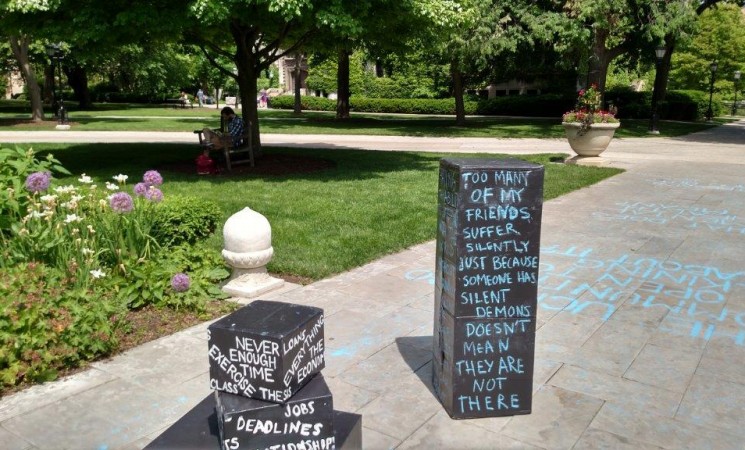Archived Content
This page is archived and provided for historical reference. The content is no longer being updated, and some of the information may have changed over time and could be outdated or inaccurate.

By Anna S. Mueller, Ph.D.
A large body of research across the social sciences embraces the idea that social relationships play an important and positive role in promoting mental health and particularly preventing suicide. Yet research also shows there can be downsides to strong social ties and to living within socially-cohesive communities. Strong social ties can expose individuals to stress or facilitate the diffusion of unhealthy behaviors even suicidality. When experienced at the community-level, high degrees of connectedness can place undue burdens on community members, including the loss of privacy. Socially-cohesive communities also tend to house coherent local cultures, with clear expectations for group members, placing heavy constraints on people’s identities and behaviors. Unfortunately, such aspects of community are rarely considered in the suicide literature, despite their potential to provide important insights into why suicide clusters emerge and persist.
Social Relationships Can Promote Mental Health and Prevent Suicide
In a recent study published in the American Sociological Review, my colleague Seth Abrutyn and I examine how a community’s social structure and culture may shape adolescent suicide. To do this, we conducted an in-depth case study of an affluent community we call “Poplar Grove,” which has a serious adolescent suicide problem, including a history of clusters. Using an abductive analytic approach and data from interviews and focus groups with youth, young adults, mental health workers, and parents (N=110), we identified links between the community’s structure and culture and adolescent vulnerability to suicide. We also compared the experiences of people in Poplar Grove to a group of similar-aged youth who were also bereaved by suicide, but not community members.
Community social structures also can foster adolescent vulnerabilities toward suicide
First, in terms of social structure, Poplar Grove is a highly, socially cohesive community, where everybody knows everybody. While respondents reported that at times the connectedness felt like a wonderful social safety net, they also worried about the spread of gossip and private information. The community is also home to a homogeneous set of cultural beliefs that emphasize academic excellence. Virtually all of the community members we interviewed recognized the specific, narrow ideals that children (and parents) were supposed to live up to. As a result, both parents and youth felt intense pressure to meet these high expectations and in turn, feared the shame and stigma of failures becoming public knowledge.
Two community structure pathways may influence adolescent suicidal thoughts
We also found evidence that this structural–cultural reality may increase youths’ vulnerabilities to suicide through two pathways. First, youth reported feeling intense emotional pain related to real, perceived, and anticipated failures. Second, we found that parents and youth were reluctant to seek mental health care when problems arose precisely because they feared what other people would think or that they would be stigmatized or perceived badly. We also linked these two pathways to actual suicide deaths in the community.
These findings have several important implications for (1) our understanding why youth die by suicide, (2) strategies for suicide prevention, and (3) sociological theory.
Social forces, not just psychological and emotional factors, can facilitate suicidal thoughts
Regarding why youth die by suicide, our study points to the importance of considering the role of social forces in suicide in addition to psychological and emotional factors. In the case of Poplar Grove, youth’s psychological pain had social roots. The pain related to their struggle to cope with the intense pressure and threat of exposure as a “failure”. This finding challenges and complements psychological models of suicide.
Regarding strategies for suicide prevention, our study illustrates how prevention strategies must take a broad approach to be effective. Alleviating the social roots of suicide, such as the sources of distress and unwillingness to seek help in Poplar Grove, is as important as identifying youth who are suffering from mental health problems. Additionally, though social connectedness is often seen as a way to prevent suicide, the potential downsides of connectedness should be considered when identifying prevention strategies.
To prevent suicide, consider positive + negative influences of youth’s connections
Finally, our study offers a re-imagination of sociological theory; specifically, a re-thinking of Durkheim’s ideas about “altruistic” and “fatalistic” suicide, two types of suicide predicated on high levels of integration and regulation, respectively. Though Durkheim saw these types as exceedingly rare in “modern” societies, when we consider the meso-level of society—in our case, the community—high levels of integration and regulation matter in important ways to suicide.
Fields of culture, sociology, and anthropology can enhance future mental health promotion and suicide prevention research
We also argue that Durkheim’s regulation and fatalistic suicide is an ideal theoretical place to incorporate insights from cultural sociology and anthropology. While integration captures the social structure of groups, regulation can help us conceptualize group’s local culture. This new theoretical approach can help us more accurately capture the experience of daily life in communities in ways that are meaningful for suicide prevention.
Sociology as a discipline has unique tools to investigate why there are spatial patterns in suicide, like the suicide clusters found in Poplar Grove. Thus, we hope this study (1) inspires more sociologists to contribute to understanding suicide while also (2) encouraging other disciplines to consider how seemingly psychological problems like suicide can have social roots.
Original Citation
Mueller, Anna S. & Abrutyn, Seth. 2016. “Adolescents Under Pressure: A New Durkheimian Framework for Understanding Adolescent Suicide in a Cohesive Community.” American Sociological Review 81(5): 877-899.
About the Author
 Anna S. Mueller is assistant professor in the Department of Comparative Human Development and the college and research associate at the Population Research Center at the University of Chicago. She received her B.A. in economics from Wellesley College in 2002 and her Ph.D. in sociology in 2011 from the The University of Texas at Austin. Mueller’s research examines how social relationships and social contexts shape adolescent health and wellbeing over the transition to adulthood, with a focus on adolescent suicide. Her conceptual interests are matched by her methodological interests in social network analysis, multi-level modeling, and in-depth case studies of adolescent societies. Mueller’s research on suicide has received several awards from the American Sociological Association, including the Eliot Friedson Outstanding Publication Award from the Section on Medical Sociology. More information on her work can be found at http://www.annasmueller.com.
Anna S. Mueller is assistant professor in the Department of Comparative Human Development and the college and research associate at the Population Research Center at the University of Chicago. She received her B.A. in economics from Wellesley College in 2002 and her Ph.D. in sociology in 2011 from the The University of Texas at Austin. Mueller’s research examines how social relationships and social contexts shape adolescent health and wellbeing over the transition to adulthood, with a focus on adolescent suicide. Her conceptual interests are matched by her methodological interests in social network analysis, multi-level modeling, and in-depth case studies of adolescent societies. Mueller’s research on suicide has received several awards from the American Sociological Association, including the Eliot Friedson Outstanding Publication Award from the Section on Medical Sociology. More information on her work can be found at http://www.annasmueller.com.








